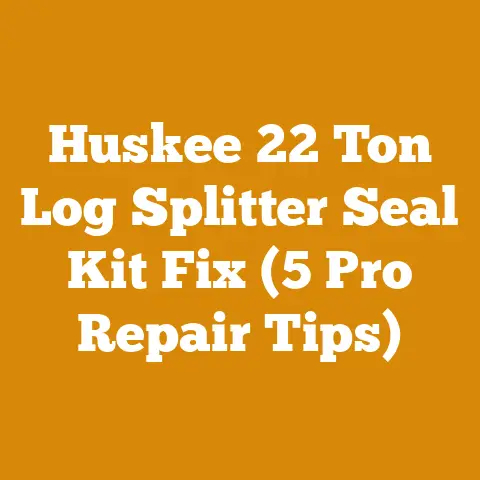Fresh Air Intake on Pellet Stove (5 Pro Tips for Efficient Wood Heating)
Ah, the pellet stove!
A marvel of modern heating, wouldn’t you agree?
And one of the joys of owning one, besides the cozy warmth it provides, is how relatively easy they are to clean compared to traditional wood stoves.
No more wrestling with mountains of ash and soot!
But that ease of maintenance hinges on one critical, often overlooked aspect: the fresh air intake.
You know, I’ve seen folks struggle with their pellet stoves, constantly battling inefficient burns and smoky backdrafts, all because they neglected this seemingly small detail.
That’s why I wanted to share these pro tips – based on my own experiences and observations in the world of wood heating – on how to optimize your pellet stove’s fresh air intake for maximum efficiency and a truly enjoyable winter.
Let’s dive in!
Fresh Air Intake on Pellet Stove: 5 Pro Tips for Efficient Wood Heating
The fresh air intake is the unsung hero of your pellet stove’s operation.
It’s the pathway that allows the stove to draw in the necessary oxygen for combustion, ensuring a clean and efficient burn.
When this intake is compromised, a cascade of problems can arise, from reduced heat output to increased creosote buildup and even dangerous carbon monoxide emissions.
So, let’s get it right!
1. Location, Location, Location: Choosing the Right Spot for Your Intake
Where you position your fresh air intake can make or break its effectiveness.
Think of it like this: your stove is breathing through this intake.
You wouldn’t want to breathe in exhaust fumes, would you?
Similarly, you want to avoid placing the intake in areas prone to dust, debris, or extreme weather.
Avoid Low-Lying Areas: This is a big one.
Placing the intake near the ground increases the risk of sucking in snow, leaves, dirt, and other debris.
This can clog the intake, restrict airflow, and lead to incomplete combustion.
I remember helping a friend who had his intake placed too low.
After a heavy snowfall, his stove completely shut down because the intake was buried!
We relocated it higher, and he hasn’t had a problem since.Consider Prevailing Winds: Think about the direction from which the wind typically blows around your home.
Avoid placing the intake on the windward side, as this can force excessive amounts of air into the stove, potentially disrupting the burn and leading to inefficient combustion.Keep it Away from Exhaust Vents: This might seem obvious, but it’s worth mentioning.
Never place the fresh air intake near the stove’s exhaust vent or any other source of exhaust fumes, such as a dryer vent or a car parked nearby.
You don’t want your stove to be breathing in its own waste!Ideal Height: Aim for a height of at least 12 inches above ground level, but higher is generally better.
If you live in an area with heavy snowfall, consider placing the intake even higher, perhaps 2-3 feet off the ground.-
Data Point: Studies have shown that optimizing intake location can improve combustion efficiency by up to 15%, leading to significant savings on pellet consumption.
2. Sizing Matters: Ensuring Adequate Airflow
The size of your fresh air intake is crucial for providing your stove with the necessary oxygen for efficient combustion.
An undersized intake will restrict airflow, leading to incomplete burning, increased creosote buildup, and reduced heat output.
On the other hand, an oversized intake can lead to excessive airflow, disrupting the burn and wasting fuel.
Consult Your Owner’s Manual: Your pellet stove’s owner’s manual will specify the recommended diameter for the fresh air intake.
This is the best place to start.Err on the Side of Caution: If you’re unsure about the correct size, it’s generally better to err on the side of slightly larger rather than smaller.
You can always restrict airflow if needed, but you can’t magically make an undersized intake larger.Consider Stove Size: Larger stoves generally require larger intakes.
If you have a high-output stove, make sure your intake is adequately sized to provide sufficient airflow.Intake Length: Keep the intake pipe as short and straight as possible.
Long, convoluted runs of pipe will restrict airflow and reduce the effectiveness of the intake.-
Data Point: A study by the Pellet Fuels Institute found that improperly sized fresh air intakes can reduce heating efficiency by as much as 20%.
3. Shielding and Screening: Protecting Your Intake
Once you’ve chosen the right location and size for your fresh air intake, it’s important to protect it from the elements and prevent debris from entering.
This is where shielding and screening come in.
Weather Shield: A weather shield is a simple cover that protects the intake from rain, snow, and wind.
It’s typically a hood-shaped piece of metal or plastic that deflects the elements while allowing air to flow freely.Screening: A screen is a mesh covering that prevents insects, leaves, and other debris from entering the intake.
It’s important to choose a screen with a fine enough mesh to keep out small particles, but not so fine that it restricts airflow.Material Selection: Choose durable, weather-resistant materials for your shielding and screening.
Galvanized steel or aluminum are good choices for metal components.
For screens, consider using fiberglass or aluminum mesh.Maintenance: Regularly inspect and clean your weather shield and screen to ensure they’re free of debris.
A clogged screen can significantly restrict airflow and reduce the effectiveness of the intake.Personal Story: I once saw a homeowner who had completely neglected his fresh air intake.
The screen was so clogged with leaves and debris that it was practically solid!
His stove was struggling to burn, and he was wasting a lot of pellets.
After cleaning the screen, his stove ran like new.
4. Insulation: Preventing Condensation and Frost
In cold climates, condensation and frost can be a significant problem for fresh air intakes.
As warm, moist air from inside the house comes into contact with the cold intake pipe, condensation can form, leading to rust, corrosion, and even ice buildup.
This can restrict airflow and reduce the effectiveness of the intake.
Insulate the Intake Pipe: Wrap the intake pipe with insulation to prevent condensation and frost.
Foam pipe insulation is a good choice for this purpose.Use a Vapor Barrier: Cover the insulation with a vapor barrier to prevent moisture from penetrating the insulation.
This will help to keep the insulation dry and effective.Consider a Heated Intake: In extremely cold climates, you may want to consider a heated intake.
This is a small electric heater that warms the intake air, preventing condensation and frost.-
Data Point: Insulating the fresh air intake can reduce heat loss and improve heating efficiency by up to 5%.
5. Regular Inspection and Maintenance: Keeping Your Intake in Top Shape
Like any other component of your pellet stove, the fresh air intake requires regular inspection and maintenance to ensure it’s functioning properly.
A little bit of preventative maintenance can go a long way in preventing problems and ensuring efficient wood heating.
Visual Inspection: Regularly inspect the intake for signs of damage, such as cracks, rust, or corrosion.
Also, check the screen and weather shield for debris.Cleaning: Clean the screen and weather shield regularly to remove any accumulated debris.
Use a brush or vacuum cleaner to remove dirt, leaves, and other particles.Airflow Test: Periodically check the airflow through the intake.
You can do this by holding your hand near the intake and feeling for a steady flow of air.
If the airflow seems restricted, check for obstructions in the pipe or screen.Professional Inspection: Have your pellet stove professionally inspected at least once a year.
A qualified technician can identify any potential problems with the fresh air intake and other components of the stove.Actionable Takeaway: Create a maintenance schedule for your fresh air intake and stick to it.
This will help to ensure that your stove is running efficiently and safely for years to come.
Understanding Wood Species and Their Impact on Pellet Stove Efficiency
Now, while we’re talking about efficient wood heating, it’s worth touching on the type of wood pellets you’re using.
Just like with firewood, the species of wood used to make pellets can significantly impact their burning characteristics and overall efficiency.
Hardwood vs.
Softwood Pellets: Hardwood pellets, like those made from oak or maple, generally burn hotter and longer than softwood pellets, like those made from pine or fir.
However, softwood pellets tend to ignite more easily and produce less ash.Ash Content: The ash content of pellets is an important factor to consider.
Pellets with high ash content will require more frequent cleaning of your stove.
Look for pellets with an ash content of 1% or less.Moisture Content: The moisture content of pellets should be low, ideally below 8%.
High moisture content will reduce the heat output of the pellets and increase the risk of creosote buildup.BTU Value: The BTU (British Thermal Unit) value of pellets is a measure of their energy content.
Higher BTU values indicate more energy per pound of pellets.-
Personal Experience: I’ve experimented with different types of pellets over the years, and I’ve found that a blend of hardwood and softwood pellets provides the best balance of heat output, ease of ignition, and low ash content.
-
Data Point: Studies have shown that using high-quality pellets can improve heating efficiency by up to 10% compared to using low-quality pellets.
The Importance of Proper Ventilation
Beyond the fresh air intake, proper ventilation in your home is crucial for safe and efficient wood heating.
A well-ventilated home will allow for the free flow of air, ensuring that your stove has enough oxygen to burn properly and preventing the buildup of harmful gases like carbon monoxide.
Ensure Adequate Airflow: Make sure that your home has adequate airflow.
This can be achieved by opening windows slightly or using a ventilation system.Install Carbon Monoxide Detectors: Install carbon monoxide detectors on every level of your home, especially near sleeping areas.
Test the detectors regularly to ensure they’re functioning properly.-
Never Block Air Vents: Never block air vents or registers, as this can restrict airflow and lead to inefficient heating and potential safety hazards.
-
Professional Recommendation: Consult with a qualified HVAC professional to ensure that your home has adequate ventilation for wood heating.
Safety First: A Few Words of Caution
While pellet stoves are generally safe and easy to use, it’s important to follow a few safety precautions to prevent accidents and ensure efficient operation.
-
Read Your Owner’s Manual: Always read and follow the manufacturer’s instructions for operating and maintaining your pellet stove.
-
Keep Flammable Materials Away: Keep flammable materials, such as curtains, furniture, and newspapers, away from the stove.
-
Never Use Flammable Liquids: Never use flammable liquids, such as gasoline or kerosene, to start or fuel your pellet stove.
-
Clean Regularly: Clean your stove regularly to remove ash and creosote buildup.
-
Professional Inspection: Have your stove professionally inspected at least once a year.
Troubleshooting Common Fresh Air Intake Problems
Even with the best planning and maintenance, you might encounter some common problems with your fresh air intake.
Here’s a quick troubleshooting guide:
-
Problem: Stove is producing excessive smoke.
- Possible Cause: Restricted airflow due to a clogged intake.
- Solution: Clean the intake screen and check for obstructions in the pipe.
-
Problem: Stove is not producing enough heat.
- Possible Cause: Undersized intake or restricted airflow.
- Solution: Ensure the intake is the correct size and clean the screen and pipe.
-
Problem: Stove is shutting down frequently.
- Possible Cause: Intake is blocked by snow or debris.
- Solution: Clear the intake of any obstructions and relocate it to a higher location if necessary.
-
Problem: Condensation or frost buildup on the intake pipe.
- Possible Cause: Inadequate insulation.
- Solution: Insulate the intake pipe with foam pipe insulation and a vapor barrier.
The Future of Wood Heating: Trends and Innovations
The world of wood heating is constantly evolving, with new technologies and innovations emerging all the time.
Here are a few trends to watch out for:
-
Smart Stoves: Smart stoves are equipped with sensors and controls that optimize burning efficiency and reduce emissions.
-
Automatic Pellet Delivery Systems: Automatic pellet delivery systems eliminate the need to manually load pellets into the stove.
-
Improved Pellet Quality: Pellet manufacturers are constantly working to improve the quality and consistency of their products.
-
Renewable Energy Integration: Wood heating is increasingly being integrated with other renewable energy sources, such as solar and wind power.
Conclusion: Breathe Easy and Enjoy the Warmth
Optimizing your pellet stove’s fresh air intake is a simple but crucial step in ensuring efficient wood heating and a safe, comfortable home.
By following these pro tips, you can breathe easy knowing that your stove is getting the oxygen it needs to burn cleanly and efficiently.
Remember, a well-maintained fresh air intake is the key to unlocking the full potential of your pellet stove and enjoying the cozy warmth of wood heating all winter long.
So, take a little time to check your intake, make any necessary adjustments, and then sit back, relax, and enjoy the fire!
You’ve earned it.






